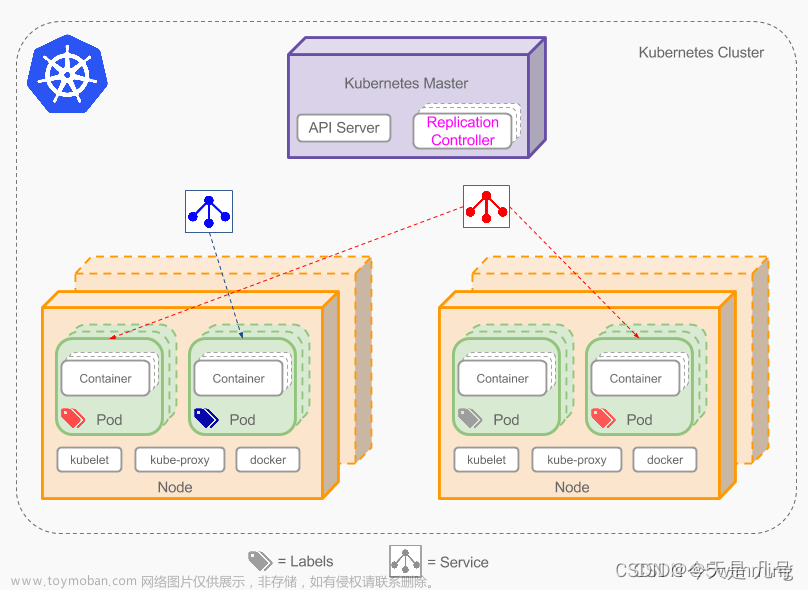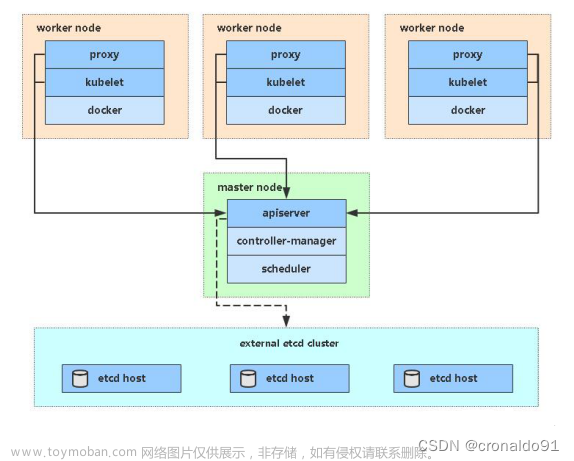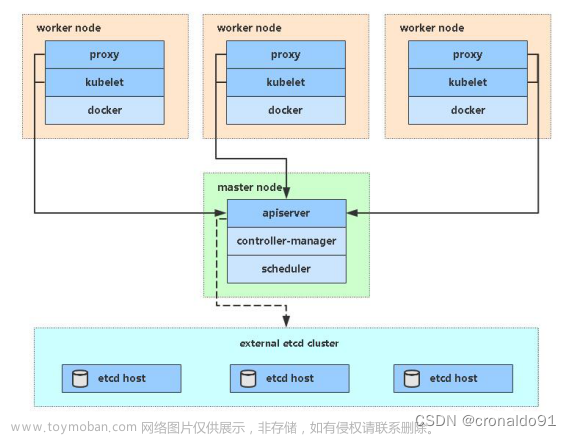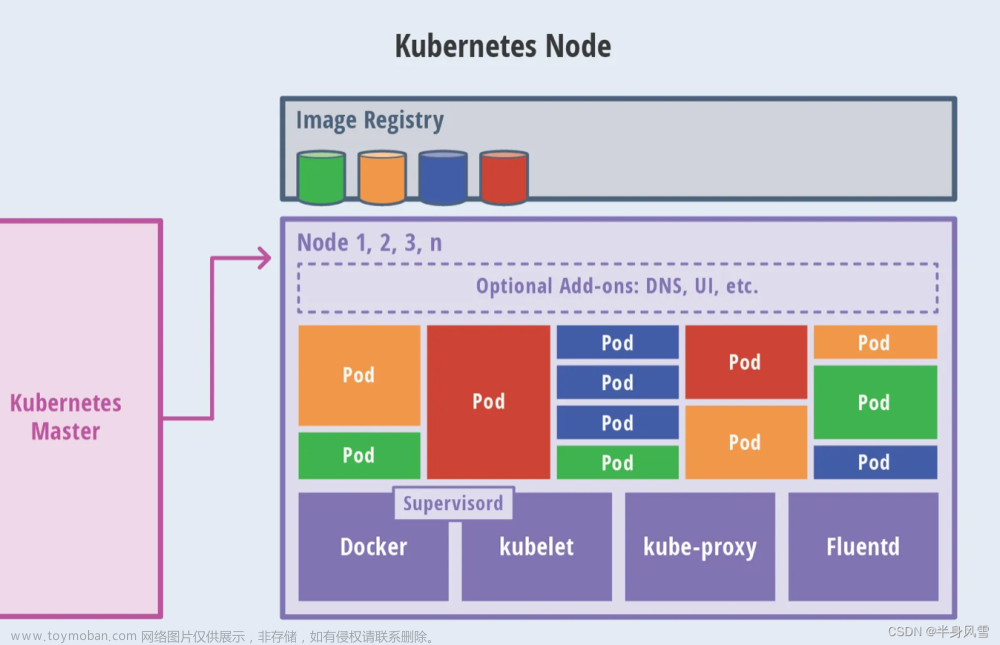目录
一 装备三台机器linux(centos)
二 准备前置环境并安装kubernetes
1 三台机器都要做如下操作
1.1 关闭防火墙:
1.2 关闭 selinux:
1.3 关闭 swap
1.4 添加主机名与 IP 对应关系
1.5 date 查看时间 (可选)
1.6 卸载系统之前的 docke 命令自行百度不做说明
1.7 安装 Docker-CE
1. 7.1 装必须的依赖
1.7.2 设置 docker repo 的 yum 位置
1.7.3 安装 docker,以及 docker-cli
1.7.4 配置 docker 加速器(自己去阿里云镜像加速器粘贴 下面是例子 不一定好用)
1.7.5 动 docker & 设置 docker 开机自启
1.7.6 添加阿里云 yum
1.8 安装 kubeadm,kubelet 和 kubectl
2 部署 k8s-master
2.1 master 机器上执行
2.2 等待上诉命令执行完成
2.3 master执行
2.4 在master节点上安装网络
2.5 在其他的分支节点执行(k8s-node1 k8s-node2)
三 安装 kubesphere
1.1 创建StorageClass存储
1.1.1 创建kubesphere-system命名空间
1.1.2 创建rbac授权
1.1.3 创建storageclass的deployment
1.1.4 创建StorageClass
1.1.5 查看StorageClass
1.1.6 设置默认的StorageClass
1.2 部署最小化Kubersphere
1.2.1 下载kubersphere的配控文件
1.2.2 执行如下命令启动
1.2.3 查看安装日志
完结撒花
一 装备三台机器linux(centos)
ip hostname
192.168.49.101 k8s-master
192.168.49.102 k8s-node1
192.168.49.103 k8s-node2
二 准备前置环境并安装kubernetes
1 三台机器都要做如下操作
1.1 关闭防火墙:
systemctl stop firewalld
systemctl disable firewalld1.2 关闭 selinux:
sed -i 's/enforcing/disabled/'
/etc/selinux/config setenforce 01.3 关闭 swap
swapoff -a #临时
sed -ri 's/.*swap.*/#&/' /etc/fstab #永久
free -g #验证,swap 必须为 0;1.4 添加主机名与 IP 对应关系
vi /etc/hosts
192.168.49.101 k8s-master
192.168.49.101 k8s-node1
192.168.49.101 k8s-node21.5 date 查看时间 (可选)
yum install -y
ntpdate ntpdate time.windows.com 同步最新时间1.6 卸载系统之前的 docke 命令自行百度不做说明
1.7 安装 Docker-CE
1. 7.1 装必须的依赖
sudo yum install -y yum-utils device-mapper-persistent-data lvm21.7.2 设置 docker repo 的 yum 位置
sudo yum-config-manager --add-repo https://download.docker.com/linux/centos/docker-ce.repo1.7.3 安装 docker,以及 docker-cli
sudo yum install -y docker-ce docker-ce-cli containerd.io1.7.4 配置 docker 加速器(自己去阿里云镜像加速器粘贴 下面是例子 不一定好用)
sudo mkdir -p /etc/docker sudo tee /etc/docker/daemon.json <<-'EOF' { "registry-mirrors": ["https://82m9ar63.mirror.aliyuncs.com"] } EOF sudo systemctl daemon-reload sudo systemctl restart dock1.7.5 动 docker & 设置 docker 开机自启
systemctl enable docker1.7.6 添加阿里云 yum
cat > /etc/yum.repos.d/kubernetes.repo << EOF [kubernetes] name=Kubernetes baseurl=https://mirrors.aliyun.com/kubernetes/yum/repos/kubernetes-el7-x86_64 enabled=1 gpgcheck=0 repo_gpgcheck=0 gpgkey=https://mirrors.aliyun.com/kubernetes/yum/doc/yum-key.gpg https://mirrors.aliyun.com/kubernetes/yum/doc/rpm-package-key.gpg EOF1.8 安装 kubeadm,kubelet 和 kubectl
yum list|grep kube
yum install -y kubelet-1.19.0 kubeadm-1.19.0 kubectl-1.19.0
systemctl enable kubelet
systemctl start kubele2 部署 k8s-master
2.1 master 机器上执行
kubeadm init --kubernetes-version=v1.19.0 \
--apiserver-advertise-address=192.168.49.101 \ # apiserver-advertise-address 改成你自己的IP
--image-repository registry.aliyuncs.com/google_containers \
--service-cidr=10.1.0.0/16 \
--pod-network-cidr=10.244.0.0/162.2 等待上诉命令执行完成
执行打印的日志
mkdir -p $HOME/.kube
sudo cp -i /etc/kubernetes/admin.conf $HOME/.kube/config
sudo chown $(id -u):$(id -g) $HOME/.kube/config
You should now deploy a pod network to the cluster.
Run "kubectl apply -f [podnetwork].yaml" with one of the options listed at:
https://kubernetes.io/docs/concepts/cluster-administration/addons/
Then you can join any number of worker nodes by running the following on each as root:
kubeadm join 192.168.49.101:6443 --token 8alqa1.28d3n8pjzxlmex1q --discovery-token-ca-cert-hash sha256:a3883e22dbdbca2ce3c1de98b5e58379e38d3750abfb7d82bd014526b834061e 2.3 master执行
mkdir -p $HOME/.kube
sudo cp -i /etc/kubernetes/admin.conf $HOME/.kube/config
sudo chown $(id -u):$(id -g) $HOME/.kube/config2.4 在master节点上安装网络
kube-flannel.yml
内容如下:
---
apiVersion: policy/v1beta1
kind: PodSecurityPolicy
metadata:
name: psp.flannel.unprivileged
annotations:
seccomp.security.alpha.kubernetes.io/allowedProfileNames: docker/default
seccomp.security.alpha.kubernetes.io/defaultProfileName: docker/default
apparmor.security.beta.kubernetes.io/allowedProfileNames: runtime/default
apparmor.security.beta.kubernetes.io/defaultProfileName: runtime/default
spec:
privileged: false
volumes:
- configMap
- secret
- emptyDir
- hostPath
allowedHostPaths:
- pathPrefix: "/etc/cni/net.d"
- pathPrefix: "/etc/kube-flannel"
- pathPrefix: "/run/flannel"
readOnlyRootFilesystem: false
runAsUser:
rule: RunAsAny
supplementalGroups:
rule: RunAsAny
fsGroup:
rule: RunAsAny
allowPrivilegeEscalation: false
defaultAllowPrivilegeEscalation: false
allowedCapabilities: ['NET_ADMIN', 'NET_RAW']
defaultAddCapabilities: []
requiredDropCapabilities: []
hostPID: false
hostIPC: false
hostNetwork: true
hostPorts:
- min: 0
max: 65535
seLinux:
rule: 'RunAsAny'
---
kind: ClusterRole
apiVersion: rbac.authorization.k8s.io/v1
metadata:
name: flannel
rules:
- apiGroups: ['extensions']
resources: ['podsecuritypolicies']
verbs: ['use']
resourceNames: ['psp.flannel.unprivileged']
- apiGroups:
- ""
resources:
- pods
verbs:
- get
- apiGroups:
- ""
resources:
- nodes
verbs:
- list
- watch
- apiGroups:
- ""
resources:
- nodes/status
verbs:
- patch
---
kind: ClusterRoleBinding
apiVersion: rbac.authorization.k8s.io/v1
metadata:
name: flannel
roleRef:
apiGroup: rbac.authorization.k8s.io
kind: ClusterRole
name: flannel
subjects:
- kind: ServiceAccount
name: flannel
namespace: kube-system
---
apiVersion: v1
kind: ServiceAccount
metadata:
name: flannel
namespace: kube-system
---
kind: ConfigMap
apiVersion: v1
metadata:
name: kube-flannel-cfg
namespace: kube-system
labels:
tier: node
app: flannel
data:
cni-conf.json: |
{
"name": "cbr0",
"cniVersion": "0.3.1",
"plugins": [
{
"type": "flannel",
"delegate": {
"hairpinMode": true,
"isDefaultGateway": true
}
},
{
"type": "portmap",
"capabilities": {
"portMappings": true
}
}
]
}
net-conf.json: |
{
"Network": "10.244.0.0/16",
"Backend": {
"Type": "vxlan"
}
}
---
apiVersion: apps/v1
kind: DaemonSet
metadata:
name: kube-flannel-ds
namespace: kube-system
labels:
tier: node
app: flannel
spec:
selector:
matchLabels:
app: flannel
template:
metadata:
labels:
tier: node
app: flannel
spec:
affinity:
nodeAffinity:
requiredDuringSchedulingIgnoredDuringExecution:
nodeSelectorTerms:
- matchExpressions:
- key: kubernetes.io/os
operator: In
values:
- linux
hostNetwork: true
priorityClassName: system-node-critical
tolerations:
- operator: Exists
effect: NoSchedule
serviceAccountName: flannel
initContainers:
- name: install-cni-plugin
image: rancher/mirrored-flannelcni-flannel-cni-plugin:v1.1.0
command:
- cp
args:
- -f
- /flannel
- /opt/cni/bin/flannel
volumeMounts:
- name: cni-plugin
mountPath: /opt/cni/bin
- name: install-cni
image: rancher/mirrored-flannelcni-flannel:v0.18.1
command:
- cp
args:
- -f
- /etc/kube-flannel/cni-conf.json
- /etc/cni/net.d/10-flannel.conflist
volumeMounts:
- name: cni
mountPath: /etc/cni/net.d
- name: flannel-cfg
mountPath: /etc/kube-flannel/
containers:
- name: kube-flannel
image: rancher/mirrored-flannelcni-flannel:v0.18.1
command:
- /opt/bin/flanneld
args:
- --ip-masq
- --kube-subnet-mgr
resources:
requests:
cpu: "100m"
memory: "50Mi"
limits:
cpu: "100m"
memory: "50Mi"
securityContext:
privileged: false
capabilities:
add: ["NET_ADMIN", "NET_RAW"]
env:
- name: POD_NAME
valueFrom:
fieldRef:
fieldPath: metadata.name
- name: POD_NAMESPACE
valueFrom:
fieldRef:
fieldPath: metadata.namespace
- name: EVENT_QUEUE_DEPTH
value: "5000"
volumeMounts:
- name: run
mountPath: /run/flannel
- name: flannel-cfg
mountPath: /etc/kube-flannel/
- name: xtables-lock
mountPath: /run/xtables.lock
volumes:
- name: run
hostPath:
path: /run/flannel
- name: cni-plugin
hostPath:
path: /opt/cni/bin
- name: cni
hostPath:
path: /etc/cni/net.d
- name: flannel-cfg
configMap:
name: kube-flannel-cfg
- name: xtables-lock
hostPath:
path: /run/xtables.lock
type: FileOrCreate
vim kube-flannel.yml
在master上执行
kubectl apply -f kube-flannel.yml
查看执行情况 kubectl get pods --all-namespaces 所有状态为Running
查看主机运行状态 kubectl get nodes 如图:

2.5 在其他的分支节点执行(k8s-node1 k8s-node2)
kubeadm join 192.168.49.101:6443 --token 8alqa1.28d3n8pjzxlmex1q --discovery-token-ca-cert-hash sha256:a3883e22dbdbca2ce3c1de98b5e58379e38d3750abfb7d82bd014526b834061e
分支节点执行上述命令等待所有机器加入master
查看所有机器状态如下为成功

如果到此时 等待时间过久 或者是2.1 kubeadm init..... 失败
重装k8s 再次尝试
卸载k8s的命令
systemctl stop kubelet
systemctl stop etcd
systemctl stop docker
kubeadm reset -f
modprobe -r ipip
lsmod
rm -rf ~/.kube/
rm -rf /etc/kubernetes/
rm -rf /etc/systemd/system/kubelet.service.d
rm -rf /etc/systemd/system/kubelet.service
rm -rf /usr/bin/kube*
rm -rf /etc/cni
rm -rf /opt/cni
rm -rf /var/lib/etcd
rm -rf /var/etcd
yum -y remove kube*
yum clean all
yum -y update
yum makecache多执行几次 保证删除干净 如果master 卸载不了 重启机器再尝试删除
删除成功后 再执行 1.8 -2.5 小结的操作
到此k8s 安装成功 自己可以创建pod service 验证下 百度有
三 安装 kubesphere
1.1 创建StorageClass存储
1.1.1 创建kubesphere-system命名空间
vim ks-namespace.yaml
apiVersion: v1
kind: Namespace
metadata:
name: kubesphere-system
labels:
name: kubesphere-system
kubectl apply -f ks-namespace.yaml
1.1.2 创建rbac授权
vim sc-rbac.yaml
apiVersion: v1
kind: ServiceAccount
metadata:
name: nfs-client-provisioner
namespace: kubesphere-system
---
apiVersion: rbac.authorization.k8s.io/v1
kind: ClusterRole
metadata:
name: nfs-client-provisioner-cr
rules:
- apiGroups: [""]
resources: ["persistentvolumes"]
verbs: ["get","list","watch","create","delete"]
- apiGroups: [""]
resources: ["persistentvolumeclaims"]
verbs: ["get","list","watch","update"]
- apiGroups: ["storage.k8s.io"]
resources: ["storageclasses"]
verbs: ["get","list","watch"]
- apiGroups: [""]
resources: ["events"]
verbs: ["list","watch","create","update","patch"]
- apiGroups: [""]
resources: ["endpoints"]
verbs: ["create","delete","get","list","watch","patch","update"]
---
apiVersion: rbac.authorization.k8s.io/v1
kind: ClusterRoleBinding
metadata:
name: nfs-client-provisioner-crb
subjects:
- kind: ServiceAccount
name: nfs-client-provisioner
namespace: kubesphere-system
roleRef:
kind: ClusterRole
name: nfs-client-provisioner-cr
apiGroup: rbac.authorization.k8s.io
kubectl apply -f sc-rbac.yaml
1.1.3 创建storageclass的deployment
vim sc-deployment.yaml
NFS_SERVER 设置为安装nfs服务的服务器ip地址
NFS_PATH 即安装nfs服务的时候创建的挂载目录
volumes中的nfs同样需要配置对应的nfs环境信息
vim sc-deployment.yaml
apiVersion: apps/v1
kind: Deployment
metadata:
name: nfs-client-provisioner
namespace: kubesphere-system
spec:
replicas: 1
selector:
matchLabels:
app: nfs-client-provisioner
strategy:
type: Recreate
template:
metadata:
labels:
app: nfs-client-provisioner
spec:
serviceAccountName: nfs-client-provisioner
containers:
- name: nfs-client-provisioner
image: registry.cn-beijing.aliyuncs.com/xngczl/nfs-subdir-external-provisione:v4.0.0
env:
- name: PROVISIONER_NAME
value: nfs-storage-class
- name: NFS_SERVER
value: 192.168.16.40
- name: NFS_PATH
value: /root/data/nfs/storageclass
volumeMounts:
- name: nfs-client-root
mountPath: /persistentvolumes
volumes:
- name: nfs-client-root
nfs:
server: 192.168.16.40
path: /root/data/nfs/storageclass
kubectl apply -f sc-deployment.yaml
1.1.4 创建StorageClass
vim sc-resource.yaml
apiVersion: storage.k8s.io/v1
kind: StorageClass
metadata:
name: nfs-storageclass
provisioner: nfs-storage-class
allowVolumeExpansion: true
reclaimPolicy: Retain
kubectl apply -f sc-resource.yaml
1.1.5 查看StorageClass
[root@master kubersphere]# kubectl get sc
NAME PROVISIONER RECLAIMPOLICY VOLUMEBINDINGMODE ALLOWVOLUMEEXPANSION AGE
nfs-storageclass nfs-storage-class Retain Immediate true 33s
sc-nexus3 kubernetes.io/no-provisioner Delete WaitForFirstConsumer false 88d
1.1.6 设置默认的StorageClass
kubectl patch storageclass nfs-storageclass -p '{"metadata": {"annotations":{"storageclass.kubernetes.io/is-default-class":"true"}}}'
再次查看,可以看到此时已经设置好默认的StorageClass了
[root@master kubersphere]# kubectl get sc
NAME PROVISIONER RECLAIMPOLICY VOLUMEBINDINGMODE ALLOWVOLUMEEXPANSION AGE
nfs-storageclass (default) nfs-storage-class Retain Immediate true 2m6s
sc-nexus3 kubernetes.io/no-provisioner Delete WaitForFirstConsumer false 88d
[root@master kubersphere]#
1.2 部署最小化Kubersphere
1.2.1 下载kubersphere的配控文件
curl -L -O https://github.com/kubesphere/ks-installer/releases/download/v3.3.1/cluster-configuration.yaml
curl -L -O https://github.com/kubesphere/ks-installer/releases/download/v3.3.1/kubesphere-installer.yamlkubersphere-installer.yaml 配置文件 注意这里不需要修改
---
apiVersion: apiextensions.k8s.io/v1
kind: CustomResourceDefinition
metadata:
name: clusterconfigurations.installer.kubesphere.io
spec:
group: installer.kubesphere.io
versions:
- name: v1alpha1
served: true
storage: true
schema:
openAPIV3Schema:
type: object
properties:
spec:
type: object
x-kubernetes-preserve-unknown-fields: true
status:
type: object
x-kubernetes-preserve-unknown-fields: true
scope: Namespaced
names:
plural: clusterconfigurations
singular: clusterconfiguration
kind: ClusterConfiguration
shortNames:
- cc
---
apiVersion: v1
kind: Namespace
metadata:
name: kubesphere-system
---
apiVersion: v1
kind: ServiceAccount
metadata:
name: ks-installer
namespace: kubesphere-system
---
apiVersion: rbac.authorization.k8s.io/v1
kind: ClusterRole
metadata:
name: ks-installer
rules:
- apiGroups:
- ""
resources:
- '*'
verbs:
- '*'
- apiGroups:
- apps
resources:
- '*'
verbs:
- '*'
- apiGroups:
- extensions
resources:
- '*'
verbs:
- '*'
- apiGroups:
- batch
resources:
- '*'
verbs:
- '*'
- apiGroups:
- rbac.authorization.k8s.io
resources:
- '*'
verbs:
- '*'
- apiGroups:
- apiregistration.k8s.io
resources:
- '*'
verbs:
- '*'
- apiGroups:
- apiextensions.k8s.io
resources:
- '*'
verbs:
- '*'
- apiGroups:
- tenant.kubesphere.io
resources:
- '*'
verbs:
- '*'
- apiGroups:
- certificates.k8s.io
resources:
- '*'
verbs:
- '*'
- apiGroups:
- devops.kubesphere.io
resources:
- '*'
verbs:
- '*'
- apiGroups:
- monitoring.coreos.com
resources:
- '*'
verbs:
- '*'
- apiGroups:
- logging.kubesphere.io
resources:
- '*'
verbs:
- '*'
- apiGroups:
- jaegertracing.io
resources:
- '*'
verbs:
- '*'
- apiGroups:
- storage.k8s.io
resources:
- '*'
verbs:
- '*'
- apiGroups:
- admissionregistration.k8s.io
resources:
- '*'
verbs:
- '*'
- apiGroups:
- policy
resources:
- '*'
verbs:
- '*'
- apiGroups:
- autoscaling
resources:
- '*'
verbs:
- '*'
- apiGroups:
- networking.istio.io
resources:
- '*'
verbs:
- '*'
- apiGroups:
- config.istio.io
resources:
- '*'
verbs:
- '*'
- apiGroups:
- iam.kubesphere.io
resources:
- '*'
verbs:
- '*'
- apiGroups:
- notification.kubesphere.io
resources:
- '*'
verbs:
- '*'
- apiGroups:
- auditing.kubesphere.io
resources:
- '*'
verbs:
- '*'
- apiGroups:
- events.kubesphere.io
resources:
- '*'
verbs:
- '*'
- apiGroups:
- core.kubefed.io
resources:
- '*'
verbs:
- '*'
- apiGroups:
- installer.kubesphere.io
resources:
- '*'
verbs:
- '*'
- apiGroups:
- storage.kubesphere.io
resources:
- '*'
verbs:
- '*'
- apiGroups:
- security.istio.io
resources:
- '*'
verbs:
- '*'
- apiGroups:
- monitoring.kiali.io
resources:
- '*'
verbs:
- '*'
- apiGroups:
- kiali.io
resources:
- '*'
verbs:
- '*'
- apiGroups:
- networking.k8s.io
resources:
- '*'
verbs:
- '*'
- apiGroups:
- edgeruntime.kubesphere.io
resources:
- '*'
verbs:
- '*'
- apiGroups:
- types.kubefed.io
resources:
- '*'
verbs:
- '*'
- apiGroups:
- monitoring.kubesphere.io
resources:
- '*'
verbs:
- '*'
- apiGroups:
- application.kubesphere.io
resources:
- '*'
verbs:
- '*'
---
kind: ClusterRoleBinding
apiVersion: rbac.authorization.k8s.io/v1
metadata:
name: ks-installer
subjects:
- kind: ServiceAccount
name: ks-installer
namespace: kubesphere-system
roleRef:
kind: ClusterRole
name: ks-installer
apiGroup: rbac.authorization.k8s.io
---
apiVersion: apps/v1
kind: Deployment
metadata:
name: ks-installer
namespace: kubesphere-system
labels:
app: ks-installer
spec:
replicas: 1
selector:
matchLabels:
app: ks-installer
template:
metadata:
labels:
app: ks-installer
spec:
serviceAccountName: ks-installer
containers:
- name: installer
image: kubesphere/ks-installer:v3.3.1
imagePullPolicy: "Always"
resources:
limits:
cpu: "1"
memory: 1Gi
requests:
cpu: 20m
memory: 100Mi
volumeMounts:
- mountPath: /etc/localtime
name: host-time
readOnly: true
volumes:
- hostPath:
path: /etc/localtime
type: ""
name: host-time
cluster-configuration.yaml 配置文件 注意这里同样不需要做任何修改
---
apiVersion: installer.kubesphere.io/v1alpha1
kind: ClusterConfiguration
metadata:
name: ks-installer
namespace: kubesphere-system
labels:
version: v3.3.1
spec:
persistence:
storageClass: "nfs-storageclass" # If there is no default StorageClass in your cluster, you need to specify an existing StorageClass here.
authentication:
# adminPassword: "" # Custom password of the admin user. If the parameter exists but the value is empty, a random password is generated. If the parameter does not exist, P@88w0rd is used.
jwtSecret: "" # Keep the jwtSecret consistent with the Host Cluster. Retrieve the jwtSecret by executing "kubectl -n kubesphere-system get cm kubesphere-config -o yaml | grep -v "apiVersion" | grep jwtSecret" on the Host Cluster.
local_registry: "" # Add your private registry address if it is needed.
# dev_tag: "" # Add your kubesphere image tag you want to install, by default it's same as ks-installer release version.
etcd:
monitoring: false # Enable or disable etcd monitoring dashboard installation. You have to create a Secret for etcd before you enable it.
endpointIps: localhost # etcd cluster EndpointIps. It can be a bunch of IPs here.
port: 2379 # etcd port.
tlsEnable: true
common:
core:
console:
enableMultiLogin: true # Enable or disable simultaneous logins. It allows different users to log in with the same account at the same time.
port: 30880
type: NodePort
# apiserver: # Enlarge the apiserver and controller manager's resource requests and limits for the large cluster
# resources: {}
# controllerManager:
# resources: {}
redis:
enabled: false
enableHA: false
volumeSize: 2Gi # Redis PVC size.
openldap:
enabled: false
volumeSize: 2Gi # openldap PVC size.
minio:
volumeSize: 20Gi # Minio PVC size.
monitoring:
# type: external # Whether to specify the external prometheus stack, and need to modify the endpoint at the next line.
endpoint: http://prometheus-operated.kubesphere-monitoring-system.svc:9090 # Prometheus endpoint to get metrics data.
GPUMonitoring: # Enable or disable the GPU-related metrics. If you enable this switch but have no GPU resources, Kubesphere will set it to zero.
enabled: false
gpu: # Install GPUKinds. The default GPU kind is nvidia.com/gpu. Other GPU kinds can be added here according to your needs.
kinds:
- resourceName: "nvidia.com/gpu"
resourceType: "GPU"
default: true
es: # Storage backend for logging, events and auditing.
# master:
# volumeSize: 4Gi # The volume size of Elasticsearch master nodes.
# replicas: 1 # The total number of master nodes. Even numbers are not allowed.
# resources: {}
# data:
# volumeSize: 20Gi # The volume size of Elasticsearch data nodes.
# replicas: 1 # The total number of data nodes.
# resources: {}
logMaxAge: 7 # Log retention time in built-in Elasticsearch. It is 7 days by default.
elkPrefix: logstash # The string making up index names. The index name will be formatted as ks-<elk_prefix>-log.
basicAuth:
enabled: false
username: ""
password: ""
externalElasticsearchHost: ""
externalElasticsearchPort: ""
alerting: # (CPU: 0.1 Core, Memory: 100 MiB) It enables users to customize alerting policies to send messages to receivers in time with different time intervals and alerting levels to choose from.
enabled: false # Enable or disable the KubeSphere Alerting System.
# thanosruler:
# replicas: 1
# resources: {}
auditing: # Provide a security-relevant chronological set of records,recording the sequence of activities happening on the platform, initiated by different tenants.
enabled: false # Enable or disable the KubeSphere Auditing Log System.
# operator:
# resources: {}
# webhook:
# resources: {}
devops: # (CPU: 0.47 Core, Memory: 8.6 G) Provide an out-of-the-box CI/CD system based on Jenkins, and automated workflow tools including Source-to-Image & Binary-to-Image.
enabled: false # Enable or disable the KubeSphere DevOps System.
# resources: {}
jenkinsMemoryLim: 8Gi # Jenkins memory limit.
jenkinsMemoryReq: 4Gi # Jenkins memory request.
jenkinsVolumeSize: 8Gi # Jenkins volume size.
events: # Provide a graphical web console for Kubernetes Events exporting, filtering and alerting in multi-tenant Kubernetes clusters.
enabled: false # Enable or disable the KubeSphere Events System.
# operator:
# resources: {}
# exporter:
# resources: {}
# ruler:
# enabled: true
# replicas: 2
# resources: {}
logging: # (CPU: 57 m, Memory: 2.76 G) Flexible logging functions are provided for log query, collection and management in a unified console. Additional log collectors can be added, such as Elasticsearch, Kafka and Fluentd.
enabled: false # Enable or disable the KubeSphere Logging System.
logsidecar:
enabled: true
replicas: 2
# resources: {}
metrics_server: # (CPU: 56 m, Memory: 44.35 MiB) It enables HPA (Horizontal Pod Autoscaler).
enabled: false # Enable or disable metrics-server.
monitoring:
storageClass: "" # If there is an independent StorageClass you need for Prometheus, you can specify it here. The default StorageClass is used by default.
node_exporter:
port: 9100
# resources: {}
# kube_rbac_proxy:
# resources: {}
# kube_state_metrics:
# resources: {}
# prometheus:
# replicas: 1 # Prometheus replicas are responsible for monitoring different segments of data source and providing high availability.
# volumeSize: 20Gi # Prometheus PVC size.
# resources: {}
# operator:
# resources: {}
# alertmanager:
# replicas: 1 # AlertManager Replicas.
# resources: {}
# notification_manager:
# resources: {}
# operator:
# resources: {}
# proxy:
# resources: {}
gpu: # GPU monitoring-related plug-in installation.
nvidia_dcgm_exporter: # Ensure that gpu resources on your hosts can be used normally, otherwise this plug-in will not work properly.
enabled: false # Check whether the labels on the GPU hosts contain "nvidia.com/gpu.present=true" to ensure that the DCGM pod is scheduled to these nodes.
# resources: {}
multicluster:
clusterRole: none # host | member | none # You can install a solo cluster, or specify it as the Host or Member Cluster.
network:
networkpolicy: # Network policies allow network isolation within the same cluster, which means firewalls can be set up between certain instances (Pods).
# Make sure that the CNI network plugin used by the cluster supports NetworkPolicy. There are a number of CNI network plugins that support NetworkPolicy, including Calico, Cilium, Kube-router, Romana and Weave Net.
enabled: false # Enable or disable network policies.
ippool: # Use Pod IP Pools to manage the Pod network address space. Pods to be created can be assigned IP addresses from a Pod IP Pool.
type: none # Specify "calico" for this field if Calico is used as your CNI plugin. "none" means that Pod IP Pools are disabled.
topology: # Use Service Topology to view Service-to-Service communication based on Weave Scope.
type: none # Specify "weave-scope" for this field to enable Service Topology. "none" means that Service Topology is disabled.
openpitrix: # An App Store that is accessible to all platform tenants. You can use it to manage apps across their entire lifecycle.
store:
enabled: false # Enable or disable the KubeSphere App Store.
servicemesh: # (0.3 Core, 300 MiB) Provide fine-grained traffic management, observability and tracing, and visualized traffic topology.
enabled: false # Base component (pilot). Enable or disable KubeSphere Service Mesh (Istio-based).
istio: # Customizing the istio installation configuration, refer to https://istio.io/latest/docs/setup/additional-setup/customize-installation/
components:
ingressGateways:
- name: istio-ingressgateway
enabled: false
cni:
enabled: false
edgeruntime: # Add edge nodes to your cluster and deploy workloads on edge nodes.
enabled: false
kubeedge: # kubeedge configurations
enabled: false
cloudCore:
cloudHub:
advertiseAddress: # At least a public IP address or an IP address which can be accessed by edge nodes must be provided.
- "" # Note that once KubeEdge is enabled, CloudCore will malfunction if the address is not provided.
service:
cloudhubNodePort: "30000"
cloudhubQuicNodePort: "30001"
cloudhubHttpsNodePort: "30002"
cloudstreamNodePort: "30003"
tunnelNodePort: "30004"
# resources: {}
# hostNetWork: false
iptables-manager:
enabled: true
mode: "external"
# resources: {}
# edgeService:
# resources: {}
gatekeeper: # Provide admission policy and rule management, A validating (mutating TBA) webhook that enforces CRD-based policies executed by Open Policy Agent.
enabled: false # Enable or disable Gatekeeper.
# controller_manager:
# resources: {}
# audit:
# resources: {}
terminal:
# image: 'alpine:3.15' # There must be an nsenter program in the image
timeout: 600 # Container timeout, if set to 0, no timeout will be used. The unit is seconds
1.2.2 执行如下命令启动
kubectl apply -f kubesphere-installer.yaml
kubectl apply -f cluster-configuration.yaml1.2.3 查看安装日志
kubectl logs -n kubesphere-system $(kubectl get pod -n kubesphere-system -l 'app in (ks-install, ks-installer)' -o jsonpath='{.items[0].metadata.name}') -f 文章来源:https://www.toymoban.com/news/detail-798921.html
文章来源:https://www.toymoban.com/news/detail-798921.html
 文章来源地址https://www.toymoban.com/news/detail-798921.html
文章来源地址https://www.toymoban.com/news/detail-798921.html
完结撒花
到了这里,关于kubernetes(k8s)+kubesphere部署的文章就介绍完了。如果您还想了解更多内容,请在右上角搜索TOY模板网以前的文章或继续浏览下面的相关文章,希望大家以后多多支持TOY模板网!














